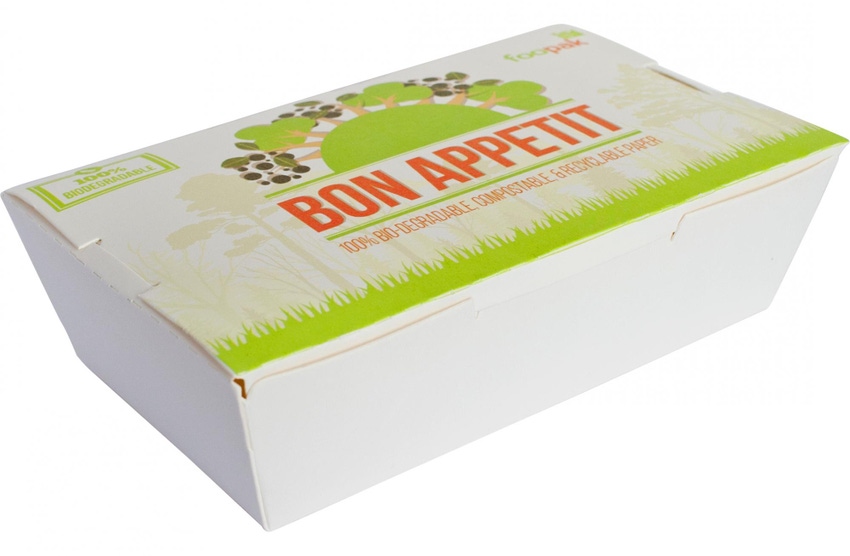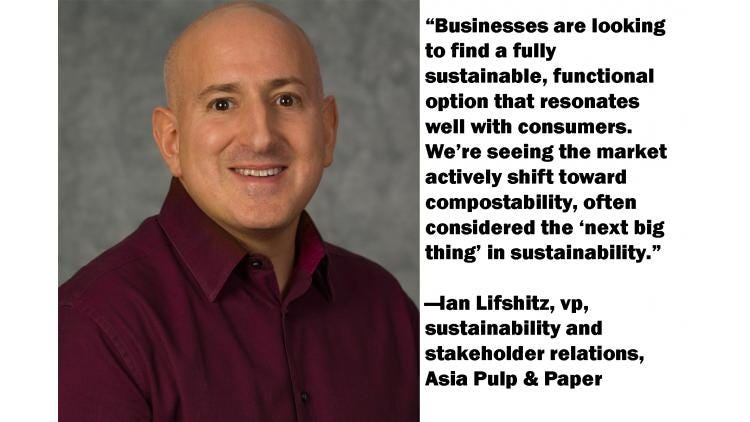New paperboard packaging matches foodservice shift in sustainability
May 22, 2018

Functional paper-based boxboard barrier material engineered for takeout food containers and more is certified as compostable.
Paper is seeing renewed interest as a packaging alternative especially in foodservice markets. According to Stratistics MRC, the Global Food Service Packaging Market, valued at $63.3 billion in 2016, is expected to reach $103.5 billion by 2023 growing at a 7.3% CAGR from 2016 to 2023. The report notes that “the paper and paperboard segment is expected to grow at a faster rate during the forecast period as a result of increasing consumer affection towards sustainable materials.”
Amidst the rising market for paper-based packaging Charta Global, strategic partner to Asia Pulp & Paper (APP), introduced a new product application, Bio Natura Food Container Board. An extension of APP’s Foopak product suite, the boxboard is comprised of the same certified biodegradable base paper as the Bio Natura cup stock launched last year and can be used for takeaway food containers and more. The new food packaging solution is suitable for takeaway food containers, sandwich boxes, cake baking trays and other related packaging for both hot and cold foods for a variety of food products from take-home entrees in restaurants to fast casual grab-and-go meals.
The FDA-certified, microwave-safe material eliminates moisture, allowing food to maintain quality when reheated and keep food fresh when frozen, and meets FTC’s Green Guides standards for biodegradability and compostability. Testing by the ISEGA Institute demonstrates that the stock can completely break down and return to nature by decomposing in 12 weeks. The product has received certificates of REACH and SVHC compliance and fully meets the qualifications of EN 13432 for compostability.
Additionally, it can be safely composted in a facility or home compost pile.
“The high-yield, multilayer folding boxboard (FBB) used in the Bio Natura Food Container Board supports a lightweight, but durable product that can be easily recycled or composted,” said Ian Lifshitz, vp, sustainability and stakeholder relations, Asia Pulp & Paper. “This is a much-needed solution in the underserved food packaging industry, utilizing virgin fiber while offering a variety of sustainable disposal options.”
Lifshitz responds to Packaging Digest’s questions.

As background, what can you tell us about the previous cup stock for the material?
Lifshitz: The market is well-positioned for what has been coined as the “sustainability shift.” Brands are seeking sustainable packaging solutions to replace polystyrene foam [expanded polystyrene, generically known as Styrofoam], poly(ethylene)-laminated paper and plastic materials. For example, brands like Dunkin’ Donuts are committing to phasing [EPS] out of their packaging options.
And as consumers are becoming more aware of the options, brands are adapting and promoting sustainability as a value proposition.
Asia Pulp & Paper’s 2017 Paper & Packaging Consumer Trends Report found that just under half of all consumers (46%) agree that the sustainable attributes of food packaging are important to them and that restaurants and food product brands should offer biodegradable packaging as an alternative to non-recyclable food packaging (45%). See also Consumers see value in biodegradable food packaging, published September 2017.
To meet these market demands, Bio Natura was launched first in the United Kingdom in early 2017 and is now available in the North America, Europe, and Asia regions.
Was there a challenge adapting the Bio Natura cup material to takeout and other food packaging?
Lifshitz: Both housed under the Foopak suite of food packaging solutions, the Bio Natura cup stock and new food box applications are made from the same exact material containing our proprietary coating. The biggest challenge in adapting the material was ensuring it would be capable of all the intended applications—freezer-ready for cold products as well as microwavable for hot entrees—while still maintaining the integrity of the packaged foods. Through testing, we were able to meet all of these thresholds while still maintaining the option for the packaging to be sustainably composted.
What can you say about the implied barrier of the “multilayer” aspect?
Lifshitz: Bio Natura is a folding boxboard, or FBB, as it is commonly referred to. Bio Natura’s moisture barrier is a water-based coating that doesn’t require the same PE-laminated materials that must be stripped if the packaging is to be composted or be made recyclable. This is a lengthy and expensive process that many recycling facilities are unequipped to handle, meaning that the paper ends up in a landfill. The aqueous coating leaves the material greaseproof, able to handle heat up to 220 degrees Celsius and easy to heat seal. Bio Natura is also free of fluorochemicals, making the board resistant to moisture, oil and grease without presenting a health hazard.
What options are available?
Lifshitz: The board is strong, flexible and customizable. As a base paperboard manufacturer, we can provide converters with the paperboard in sheet or roll format to craft a variety of food service packaging, including take-out, bakery and frozen foods. Converters can use the board to create boxes, trays, boat-style packaging, and containers with or without handles designed to carry all fast food, frozen food and fresh food.

The release notes the availability in North America: Is APP working with a U.S.- or NA-based manufacturer or distributor?
Lifshitz: We currently have trials in process with both the cup stock and food box applications in the U.S., U.K. and Asia. In North America, the cup stock is available through our strategic partner, Charta Global.
What level of NA demand is anticipated?
Lifshitz: The demand for compostable packaging options is poised to grow. Businesses are looking to find the “golden cup,” or fully sustainable, functional option that resonates well with consumers. We’re seeing the market actively shift toward compostability, often considered the “next big thing” in sustainability. Bio Natura is primed to meet both the growing U.S. market demand and rising consumer expectations.
What’s the status for customers?
Lifshitz: We currently have trials in process with both the cup stock and food box applications. The stock allows for a variety of printing options that give brands an opportunity to customize the look of the packaging. We are focusing on takeout trays for consumers looking for microwaveable, reheatable trays. One area we’re exploring is concessions—containers for food products you could buy in an entertainment venue or stadium, such as popcorn, condiments, etc.
What’s the takeaway for Packaging Digest readers, especially in the U.S.?
Lifshitz: APP is tracking the market and consumer demands. We’re seeing the rise of residential-based compost centers, seeing brands treat sustainability as an ideal value proposition and seeing consumers demand more sustainable options.
High-traffic consumer zones, like stadiums and hospitals, are consistently seeking out alternatives to the high amount of waste they produce, and in some cases, are beginning to see composting as a less expensive, healthier option.
Ultimately, packaging needs to deliver on both sustainability and functionality. But sustainable packaging isn’t what it used to be—we’re saying goodbye to unattractive, lower quality options and introducing the market to an Earth-friendly, functional, flexible alternative.
___________________________________________________________________________________
Hungry for packaging information and ideas? During EastPack 2018 (June 12-14, New York City), you’ll find a 3-day packaging conference, demos, networking opportunities and expert-led Innovation Tours.
___________________________________________________________________________________
You May Also Like


